 |
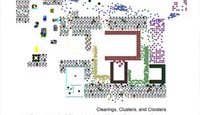
|
 |
 |
Selected Tree Matrix and “Emergent” Landscape. The material palette for the Garden is limited to 21 indigenous trees able to withstand flooding and nutrient shortfalls. Trees are combined to produce emergent landscapes and urbanisms of ever-growing complexity. |
 |
 |
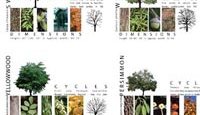 |
 |
 |
Selected Tree Matrix and “Emergent” Landscape. The material palette for the Garden is limited to 21 indigenous trees able to withstand flooding and nutrient shortfalls. Trees are combined to produce emergent landscapes and urbanisms of ever-growing complexity. |
 |
 |
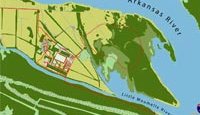 |
 |
 |
Project Context: Little Rock Recreation Corridor. The Garden of Trees is a key programmatic component of the developing riverfront. The Garden’s algorithmic strategies suggest landscape urban planning organizations beyond the scale of a project. |
 |
 |
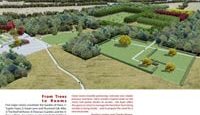 |
 |
 |
From Trees to Rooms. Didactic planting schemes switch between diverse patterns with robust species clusters at the Garden’s edge to homogeneous patterns organizing the interior. |
 |
 |
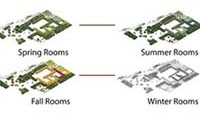 |
 |
 |
Schedule of Components: Design and Administration. Considering the intersection of successional, participatory, funding, and administrative dynamics, planning is derived from a series of networks that can be incrementally developed. |
 |
 |
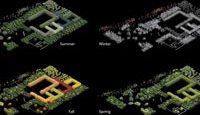 |
 |
 |
Seasonal Transformations. Trees are also selected for their aesthetic qualities related to proportion, color, fragrance, texture, and scale, and arranged according to their changing seasonal features, or succession dynamic. |
 |
 |
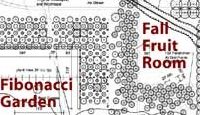 |
 |
 |
Planting Plan. Tree arrangements derived from concepts in plant sociology, and algorithmic protocols related to Fibonacci proportions and cellular automata, form a series of display rooms, akin to an art museum. |
 |
 |
 |
 |
 |
 |
 |
 |
 |
 |
|
|
 |
A 140-acre section of the 1000-acre Two Rivers island
park will be planted as a Garden of Trees. Two Rivers Park is being
developed as a regional urban park, accommodating pedestrian,
bicycle, boat, and vehicular networks. The Garden’s
planting design will highlight indigenous tree species, keeping
in mind that most people—as our client observes—often
“fail to see the trees from the forest." Identifiable
arboreal spatial arrangements like allées, bosques,
hammocks, and groves will form outdoor rooms to create a
living
educational center along the Little Rock Recreation Corridor.
Slightly different from reforestation programs that attempt
to recreate a natural condition, the Two Rivers Garden of
Trees will be a composed gallery of specimen trees. Similar
to paintings in an art museum or specimens in a natural history
museum, trees are curated to deepen appreciation for their
ecological work.
Trees are didactically organized to form
outdoor rooms of different scales. In the tradition of
museological composition—paintings
in a museum—curators display objects through thematic
narratives to facilitate memory of those objects and to dramatize
an object’s affects. Akin to the spatial sequence in
constructed memory systems, allées, bosques, lawns,
and groves in the Garden of Trees present an exhibition of
trees for our memory. The project proposes that planning
might
begin with the tree as an irreducible landscape unit to create
large-scale measures of order.
The material palette for the Garden is limited to trees and
ground cover. The site for the Garden of Trees lies within
a riparian flood zone regulated by the US Army Corps of Engineers.
Neither alterations of the ground plane nor introduction
of
architectural structures to the Garden site will be permitted.
The 21 trees selected for inclusion are indigenous to the
area’s riparian ecology and capable of withstanding
the periodic inundations to which the site is subjected.
Trees
are selected for their aesthetic qualities related to proportion,
color, fragrance, texture, and scale, and are arranged according
to their changing seasonal features, or successional dynamic.
The local experiences of participating horticultural and
forestry
consultants determined plant sociology and nutrient management.
Cloistered rooms are defined by singular and dramatic interior
affects, while exterior edges informally merge with the surrounding
Forested Clusters.
In a process known as Emergence, tree arrangements morph
from managed patterns featuring a singular dramatic effect
produced by one species to self-organizing species clusters
that merge formal rooms with the more diverse Forested Cluster.
Akin to a pixilated landscape, the Garden of Trees is an emergent
system characterized by planting algorithms applicable at
all scales. As a catalyst for future growth, the Garden suggests
an early stage urbanism without buildings.
Because the Garden’s fundamental logic is defined more
by algorithmic protocols (cellular automata and Fibonacci
proportions) than a set of fixed forms, room configurations
can change without compromising the Garden’s integrity.
Indeed, planning relies on the generation of new patterns
with greater complexity by successional development.
The State Forestry Commission is sponsoring the Garden of
Trees as a demonstration project of urban forestry—the
notion that trees provide both urban and ecological services.
The Garden is a design-build collaboration between the disciplines
of landscape architecture, architecture, planning, and horticulture
in a University Community Design Center, the State Forestry
Commission, and the Pulaski County Public Works Administration.
Since construction will be phased as funding is secured from
private sources, the plan works like a kit-of-parts to accommodate
flexibility in project development. There is no one preferred
development sequence determining room construction. Fibonacci-proportioned
plats with various grid typologies streamline surveying and
construction layout of trees, while harmonizing relationships
among parts. The planting plan manifests varying orders of
precision, recognizing that community volunteer groups will
incrementally plant large areas of the Garden with seedlings
and/or saplings donated by the State Forestry Commission.
The Forestry Commission will provide
early-stage management assistance with thinning, white-tail
deer and other nuisance
species control, nutrient, and irrigation programs. In addition
to construction of all ground surfaces (Summer 2005), Pulaski
County and the City of Little Rock public works staffs
will
partner to plant and maintain the formal allées with
mature trees (Fall 2005 and Spring 2006). The Garden of Trees
will be an important social anchor and rest stop along the
county’s 31-mile bicycle trail, and a catalyst for
the extension of its arboreal patterns throughout the river
valley
recreation corridor.
The Pulaski County administration is assembling an independent
501(c)3, or non-profit, organization—Friends of the
Garden of Trees—to sponsor and administer the Garden
once the first phase of planting and construction is completed.
Such organizations allow visionary projects developed within
local government administrations to persist beyond a founding
personality regardless of future governing administrations.
Discussions are under way with the State’s flagship
University to establish a horticultural development and learning
lab, sharing project stewardship with Friends of the Garden
of Trees. Donors are currently being solicited for funding
of various Garden Rooms and trails.
|
|
|
|
 |
 |
 |
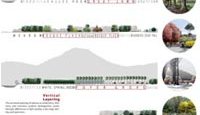 |
 |
 |
Vertical Layering. The sectional layering of species as understory, midstory, and overstory systems distinguishes rooms through differences in light quality, scale, edge density, and openness.
|
 |
 |
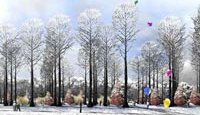 |
 |
 |
Tupelo Foyer. This is the grand entry foyer leading to the Garden’s interior. The foyer is defined by a deciduous overstory of Water Tupelos and a coniferous understory of Eastern Red Cedar; species that also mark the line between high and low ground.
|
 |
 |
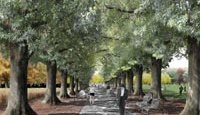 |
 |
 |
Great Lawn and Shumard Oak Alleé. This is the most majestic room in the Garden with a grand, manicured lawn bordered by an alleé of Shumard Oaks. The alleé is a wide pedestrian promenade in the tradition of the American urban park, framing views to Pinnacle Mountain. |
 |
 |
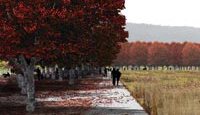 |
 |
 |
Red Fall Room. Like other cloistered rooms bordering it, this room is subsumed by a singular and dramatic interior affect, while informal exterior room edges of multiple species merge into the surrounding Forested Cluster. |
 |
 |
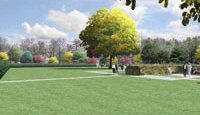 |
 |
 |
Fibonacci Garden. This subsection contains the most elegant and “slow” rooms in the Garden, recalling the English court garden with its spaces for courtship, weddings, strolling and relaxing lawn sports. Its five square rooms are generated from the Fibonacci spiral. |
 |
 |
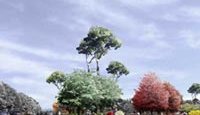 |
 |
 |
Bosque Plaza. This Plaza is a large rock garden showcasing specimen trees composed to create the coordinated floral effects of bouquets. The Plaza houses a bicycle rest station at the intersection of bicycle and pedestrian paths, accommodating different movement speeds. |
 |
 |
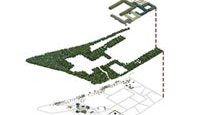 |
 |
 |
Climax Succession Development. Outer edges support a more indeterminate succession dynamic than inner ring tree arrangements whose precision requires greater human management. Inner ring rooms celebrate a more pristine social life expected in the Garden’s alleés, bosques, and groves. |
 |
 |
|
 |